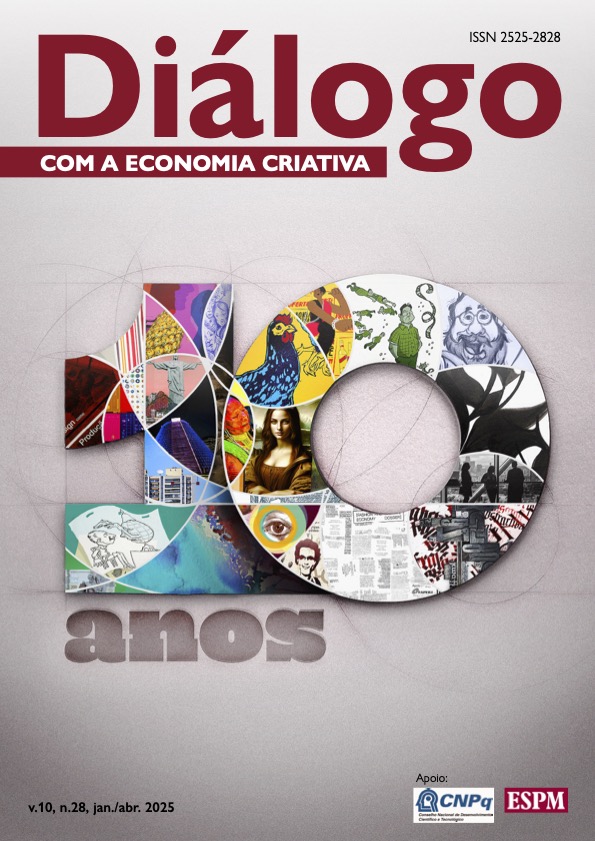A study on user experience design (UX design) perception and practices by young iPhone users from Rio
DOI:
https://doi.org/10.22398/2525-2828.925168-183Keywords:
Consumer behavior, UX Design, Interface, Usability, Focus groupAbstract
This study aims to investigate how UX Design processes are perceived by iPhone users, considering the usability of the interface and what is the impact of this perception on the consumption be havior of the users. Solomon (2016) perspective was investigated in relation to consumer behavior regarding their attitude and perception, directly and indirectly impacting their behavior towards Apple; in addition to the perspective of Nielsen (1993) and Norman (1998) regarding the technical issues that UX (user experience) covers and finally Zikmund and Babin (2011) perspective regard ing the implementation, treatment and analysis of the Focus Group. The main contributions of the study point to the high relevance of high-quality perception of UX design in promoting relevant consumer experience, which covers issues related to intuitiveness, usability, UI and even aesthetic values in promoting the construction of long-term customer loyalty with the product and, conse quently, with the brand. This can be explained by the fact that the iPhone has an operating system that is perceived as very easy to use. In this way, it ends up being practical for the user to have an iPhone to perform everything from their work tasks to those that are part of their daily lives quickly and conveniently.
References
AGNI, Edu. Etapas do design centrado no usuário. Medium, Rio de Janeiro, 9 maio 2016. Disponível em: https://www.mergo.com.br/blog/design-thinking/etapas-do-design-centrado-no-usuario-2/. Acesso em: 14 set. 2023.
AJZEN, Icek; FISHBEIN, Martin. Understanding Attitudes and Predicting Social Behavior. Hoboken: Prentice-Hall, 1980.
BARDIN, Laurence. Análise de Conteúdo. Lisboa: Edições 70, 2009.
BRYMAN, Alan. Social research methods. Oxford: University Press, 2004.
DAVIS, Fred D. Perceived Usefulness, Perceived Ease of Use, and User Acceptance of Information Technology. MIS Quarterly, v. 13, n. 3, p. 319-340, 1989. https://doi.org/10.2307/249008
DIAS, Cláudia A. Grupo Focal: técnicas de coletas de dados em pesquisas qualitativas. Informação & Sociedade, v. 10, n. 2, p. 1-12, 2000. Disponível em: http://periodicos.ufpb.br/ojs2/index.php/ies/article/viewFile/330/252. Acesso em: 17 set. 2023.
FLICK, Uwe. Uma introdução à pesquisa qualitativa. Porto Alegre: Artmed, 2009.
FOURNIER, Susan. Consumers and their brands: Developing relationship theory in consumer research. Journal of Consumer Research, v. 24, n. 4, p. 343-353, 1998. https://doi.org/10.1086/209515
GATTI, Bernardete A. Grupo Focal na pesquisa em Ciências Sociais e Humanas. Brasília: Líber Livro, 2005.
GAVIOLI, Allan. Jovens brasileiros são os que mais utilizam aparelhos eletrônicos no mundo. Exame, São Paulo, 13 maio 2022. Disponível em: https://exame.com/carreira/jovens-brasileiros-sao-os-que-mais-utilizam-aparelhos-eletronicos-no-mundo/. Acesso em: 14 set. 2023.
GIL, Antônio C. Métodos e técnicas de pesquisa social. 6. ed. São Paulo: Atlas, 2008.
GILMORE, James H.; PINE, B. Joseph. Authenticity: What consumers really want. Boston: Harvard Business School Press, 2007. Disponível em: https://books.google.com.br/books?hl=pt-BR&lr=&id=VpTSBgAAQBAJ&oi=fnd&pg=PP1&dq=Pine,+B.+J.,+%26+Gilmore,+J.+H.+Authenticity:+What+consumers+really+want.+Harvard+Business+Review,+v.85,+n.12,+p.134-139,+2007&ots=46XtLMRjx&sig=DF3kIw6v_9_GLBLfpqfUlltgyd8#v=onepage&q&f=false. Acesso em: 13 set. 2023.
GOODWIN, Kim. Designing for the Digital Age. Indianápolis: Wiley, 2009.
GUPTA, Sumeet; KIM, Hee-Wong. Value-driven internet shopping: The mental accounting theory perspective. Psychology & Marketing, v. 27, n. 1, p. 13-35, 2010. https://doi.org/10.1002/mar.20317
KUCHERIAVY, Andrew. Good UX Is Good Business: How to Reap Its Benefits. Forbes, Nova York, 19 nov. 2015. Disponível em: https://www.forbes.com/sites/forbestechcouncil/2015/11/19/good-ux-is-good-business-how-to-reap-its-benefits/?sh=69c010514e51. Acesso em: 12 set. 2023.
LEE, Chul; PARK, Gunno; KANG, Jina. The impact of convergence between science and technology on innovation. The Journal of Technology Transfer, v. 43, n. 2, p. 522-544, 2018. https://doi.org/10.1007/s10961-016-9480-9
MOON, Ji-Won; KIM, Young-Gul. Extending the TAM for a world-wide-web context. Information & Management, v. 38, n. 4, p. 217-230, 2001. https://doi.org/10.1016/S0378-7206(00)00061-6
NIELSEN, Jakob. Usability Engineering. Rio de Janeiro: Elsevier, 1993.
NORMAN, Donald. O Design do Dia a Dia. Rio de Janeiro: Rocco, 1998.
PARRISH, Rick. The US Customer Experience Index, 2016. Forrester, Cambridge, 18 jul. 2016. Disponível em: https://www.forrester.com/report/The-US-Customer-Experience-Index-2016/RES131003. Acesso em: 12 set. 2023.
QUEIRÓZ, Maria Isaura P. Variações sobre a técnica do gravador no registro da informação viva. São Paulo: T. A., 1991.
SANTOS, Altair. Consumidor fideliza produto se tiver uma boa experiência. Cimento Itambé, São Paulo, 21 nov. 2018. Disponível em: https://www.cimentoitambe.com.br/massa-cinzenta/boa-experiencia-com-produto-fideliza-consumidor/. Acesso em: 5 out. 2023.
SILVERMAN, David. Interpreting qualitative data: methods of analyzing talk, text, and interactions. Thousand Oaks: Sage, 2001.
SOLOMON, Michael R. O Comportamento do Consumidor: comprando, possuindo e sendo. 11. ed. Porto Alegre: Bookman, 2016.
TRAD, Leny A. Bomfim. Grupos focais: conceitos, procedimentos e reflexões baseadas em experiências com o uso da técnica em pesquisas de saúde. Physis: Revista de Saúde Coletiva, v. 19, n. 3, p. 777-796, 2009. https://doi.org/10.1590/S0103-73312009000300013
ZAGUETTO, Fabio. A Experiência do Usuário (UX) e o Desenvolvimento de Produtos. Medium, Rio de Janeiro, 28 abr. 2020. Disponível em: https://medium.com/@fabio.zaguetto/a-experiência-do-usuário-ux-e-o-desenvolvimento-de-produtos-2c391d7a0abb. Acesso em: 14 set. 2023.
ZIKMUND, William G.; BABIN, Barry J. Princípios da Pesquisa de Marketing. 2. ed. São Paulo: Cengage Learning, 2011.
Downloads
Published
How to Cite
Issue
Section
License

This work is licensed under a Creative Commons Attribution-NonCommercial-NoDerivatives 4.0 International License.
The copyright for articles published in this journal belongs to the author, with first publication rights to the journal.
We emphasize that the responsibility for the articles is exclusive to the author(s) and does not necessarily reflect the opinion of the Editors or ESPM.








